Photographer McNair Evans first became interested in using Photography as a tool of expression while completing his B.A. in Cultural Anthropology at Davidson College in North Carolina in 2000. He later received a M.F.A. in Photography from the Academy of Art University, San Francisco in 2011 where he currently practices today. McNair's work draws parallels between the lives of individuals and universally shared experiences and is most recognized for a distinct and metaphoric use of light. In 2011 McNair was awarded CENTER’s Curator’s Choice to a recent project, A Journal of Southern History by the San Francisco’s Museum of Modern Art, Assistant Curator Erin O’Toole. The Indie Photobook Library and Darius Himes have curated the work into an upcoming show for Fotoweek DC and it’s currently included in the Magenta Foundation’s Flash Forward 2012.
![]()
![]() There was no man that my father admired more than his father, and no one his father admired more than the man who raised him. Upon his death in November 2000, I was exposed to my father's insolvency and looming debts. Five generations of familial and financial stability fractured beneath me. While the economic effects were immediately obvious, the psychological and emotional implications lingered beneath the surface for nine years, growing to dominate my life.
There was no man that my father admired more than his father, and no one his father admired more than the man who raised him. Upon his death in November 2000, I was exposed to my father's insolvency and looming debts. Five generations of familial and financial stability fractured beneath me. While the economic effects were immediately obvious, the psychological and emotional implications lingered beneath the surface for nine years, growing to dominate my life.
![]()
![]() Recognizing their increasing influence on my work and family, I returned home in 2010 to photograph the lasting emotional and psychological landscape of Dad’s legacy. I photographed his family members and agriculturally based businesses while researching his character and actions. Dad’s life led me from rural North Carolina to New England, through moods of acceptance and frustration. Emotional states became my subject and these photographs narrate my journey between isolation and acceptance. Each speaks simultaneously of past and present experiences. Finally accepting that some questions may never be answered, this series evokes critical moods without definitive explanations.
Recognizing their increasing influence on my work and family, I returned home in 2010 to photograph the lasting emotional and psychological landscape of Dad’s legacy. I photographed his family members and agriculturally based businesses while researching his character and actions. Dad’s life led me from rural North Carolina to New England, through moods of acceptance and frustration. Emotional states became my subject and these photographs narrate my journey between isolation and acceptance. Each speaks simultaneously of past and present experiences. Finally accepting that some questions may never be answered, this series evokes critical moods without definitive explanations.
![]()
![]()
![]()
![]() In Deep South, Bulfinch 2005, Sally Mann writes, “To identify a person as a Southerner is to suggest not only that her history is inescapable and profoundly formative but that it is also paralyzing present.” A Journal of Southern History combines emotive expression, persistence of family and a landscape of loss to reveal inherent dichotomies in my rural North Carolina home. Experiential and responsive, this work utilizes photography’s relationship with literature to explore intersections between the individual and society, the immediate and the intangible.
In Deep South, Bulfinch 2005, Sally Mann writes, “To identify a person as a Southerner is to suggest not only that her history is inescapable and profoundly formative but that it is also paralyzing present.” A Journal of Southern History combines emotive expression, persistence of family and a landscape of loss to reveal inherent dichotomies in my rural North Carolina home. Experiential and responsive, this work utilizes photography’s relationship with literature to explore intersections between the individual and society, the immediate and the intangible.
![]()
![]()
![]()
![]()
![]() San Francisco based Owl & Tiger Books will release a monograph of this work in September 2013.
To see more of McNairs work visit his website.
Highlight by Taylor Curry.
San Francisco based Owl & Tiger Books will release a monograph of this work in September 2013.
To see more of McNairs work visit his website.
Highlight by Taylor Curry.

 There was no man that my father admired more than his father, and no one his father admired more than the man who raised him. Upon his death in November 2000, I was exposed to my father's insolvency and looming debts. Five generations of familial and financial stability fractured beneath me. While the economic effects were immediately obvious, the psychological and emotional implications lingered beneath the surface for nine years, growing to dominate my life.
There was no man that my father admired more than his father, and no one his father admired more than the man who raised him. Upon his death in November 2000, I was exposed to my father's insolvency and looming debts. Five generations of familial and financial stability fractured beneath me. While the economic effects were immediately obvious, the psychological and emotional implications lingered beneath the surface for nine years, growing to dominate my life.

 Recognizing their increasing influence on my work and family, I returned home in 2010 to photograph the lasting emotional and psychological landscape of Dad’s legacy. I photographed his family members and agriculturally based businesses while researching his character and actions. Dad’s life led me from rural North Carolina to New England, through moods of acceptance and frustration. Emotional states became my subject and these photographs narrate my journey between isolation and acceptance. Each speaks simultaneously of past and present experiences. Finally accepting that some questions may never be answered, this series evokes critical moods without definitive explanations.
Recognizing their increasing influence on my work and family, I returned home in 2010 to photograph the lasting emotional and psychological landscape of Dad’s legacy. I photographed his family members and agriculturally based businesses while researching his character and actions. Dad’s life led me from rural North Carolina to New England, through moods of acceptance and frustration. Emotional states became my subject and these photographs narrate my journey between isolation and acceptance. Each speaks simultaneously of past and present experiences. Finally accepting that some questions may never be answered, this series evokes critical moods without definitive explanations.



 In Deep South, Bulfinch 2005, Sally Mann writes, “To identify a person as a Southerner is to suggest not only that her history is inescapable and profoundly formative but that it is also paralyzing present.” A Journal of Southern History combines emotive expression, persistence of family and a landscape of loss to reveal inherent dichotomies in my rural North Carolina home. Experiential and responsive, this work utilizes photography’s relationship with literature to explore intersections between the individual and society, the immediate and the intangible.
In Deep South, Bulfinch 2005, Sally Mann writes, “To identify a person as a Southerner is to suggest not only that her history is inescapable and profoundly formative but that it is also paralyzing present.” A Journal of Southern History combines emotive expression, persistence of family and a landscape of loss to reveal inherent dichotomies in my rural North Carolina home. Experiential and responsive, this work utilizes photography’s relationship with literature to explore intersections between the individual and society, the immediate and the intangible.




 San Francisco based Owl & Tiger Books will release a monograph of this work in September 2013.
To see more of McNairs work visit his website.
Highlight by Taylor Curry.
San Francisco based Owl & Tiger Books will release a monograph of this work in September 2013.
To see more of McNairs work visit his website.
Highlight by Taylor Curry.

 A-B: Tell us a little about yourself your background, where you are currently living, etc?
Daniel: I was born in the mountain side of Austria - Tyrol. About 7 years ago I moved to Vienna to start up a career in photography. I'm autodidact in photography and struggle my way through all it's stages since then. But it finally starts to work out pretty well and I get there where I wanted to come to. Clients trust me more and more and hire me for what I do and give me a lot of creative freedom.
A-B: Tell us a little about yourself your background, where you are currently living, etc?
Daniel: I was born in the mountain side of Austria - Tyrol. About 7 years ago I moved to Vienna to start up a career in photography. I'm autodidact in photography and struggle my way through all it's stages since then. But it finally starts to work out pretty well and I get there where I wanted to come to. Clients trust me more and more and hire me for what I do and give me a lot of creative freedom.





 A-B: What most interests you about photography and your practice?
D:Photography is all about collecting and seeing beauty in small things to me. It's like
hunting. It's force and release at the same time. Sometimes when I take pictures of
beautiful places or nice people I start to forget everything around me. It's like
meditation. In nirvana. Hard to explain.
A-B: Your selected exhibitions list is impressive. What advise could you give our readers on how to obtain gallery representation?
D:Thank you, but it's mostly group exhibitions and small stuff. I did not really care about
gallery representation. Stuff like that just happend. I think it's best to start up with a
good idea and to take some time to photograph a nice series. Everything else will
come together afterwards. Its more a feeling than words to me.
A-B: What most interests you about photography and your practice?
D:Photography is all about collecting and seeing beauty in small things to me. It's like
hunting. It's force and release at the same time. Sometimes when I take pictures of
beautiful places or nice people I start to forget everything around me. It's like
meditation. In nirvana. Hard to explain.
A-B: Your selected exhibitions list is impressive. What advise could you give our readers on how to obtain gallery representation?
D:Thank you, but it's mostly group exhibitions and small stuff. I did not really care about
gallery representation. Stuff like that just happend. I think it's best to start up with a
good idea and to take some time to photograph a nice series. Everything else will
come together afterwards. Its more a feeling than words to me.






 For a more extensive view of Daniel's work, commissioned and personal works, visit his website.
Interview by Taylor Curry
For a more extensive view of Daniel's work, commissioned and personal works, visit his website.
Interview by Taylor Curry
 The project in progress ‘No Tail No Scale' grew from my 'double identity' as a folklorist and a photographer.
I spend a month in each of 5 cities I selected in the area between St. Petersburg and Moscow: Veliky Novgorod, Vologda, Tver, Jaroslavl, Vladimir. For each of them I find a local legend that serves as a starting point for my photographic investigation and a reflection on certain male practices and behavioral strategies.
The project in progress ‘No Tail No Scale' grew from my 'double identity' as a folklorist and a photographer.
I spend a month in each of 5 cities I selected in the area between St. Petersburg and Moscow: Veliky Novgorod, Vologda, Tver, Jaroslavl, Vladimir. For each of them I find a local legend that serves as a starting point for my photographic investigation and a reflection on certain male practices and behavioral strategies.



 Arriving at the spot I begin with a basic research: read at local libraries, find a text that puzzles me and collect related materials. After that I start visualizing my inquiries. The edit presented here comes from the chapter First Half, or How to Fight Under the Ground.
This Vologda chapter is based on a legend about two unknown men dressed in white who appeared from beneath the ground and defeated a multiple enemy. These two characters mirror each other without any apparent reason. Many other Vologda plots repeat the ‘double hero’ issue, sometimes the men become adversaries. I question this need for two, for the other half, a dialogue, and a superpower. I wonder: will the two characters fight against an enemy or with one another? What do they do underground? I study men’s need for brotherhood and for conflict. The project was initially supported by Lucie Foundation.
Arriving at the spot I begin with a basic research: read at local libraries, find a text that puzzles me and collect related materials. After that I start visualizing my inquiries. The edit presented here comes from the chapter First Half, or How to Fight Under the Ground.
This Vologda chapter is based on a legend about two unknown men dressed in white who appeared from beneath the ground and defeated a multiple enemy. These two characters mirror each other without any apparent reason. Many other Vologda plots repeat the ‘double hero’ issue, sometimes the men become adversaries. I question this need for two, for the other half, a dialogue, and a superpower. I wonder: will the two characters fight against an enemy or with one another? What do they do underground? I study men’s need for brotherhood and for conflict. The project was initially supported by Lucie Foundation.






 Daria's previous work 'Ivan and the Moon' has received awards and mentions, including: 1st prize, Viewbook Photostory Competition winner, Lucie Foundation; finalist, Burn Magazine Grant; honorable mention, Ian Parry Scholarship, as well as was published (Hotshoe, GUP) and exhibited worldwide (Houston FotoFest; Lodz Fotofetiwal; Getty Images Gallery; several shows in the Netherlands and in Russia. See can view move of her work on her website.
Daria's previous work 'Ivan and the Moon' has received awards and mentions, including: 1st prize, Viewbook Photostory Competition winner, Lucie Foundation; finalist, Burn Magazine Grant; honorable mention, Ian Parry Scholarship, as well as was published (Hotshoe, GUP) and exhibited worldwide (Houston FotoFest; Lodz Fotofetiwal; Getty Images Gallery; several shows in the Netherlands and in Russia. See can view move of her work on her website.






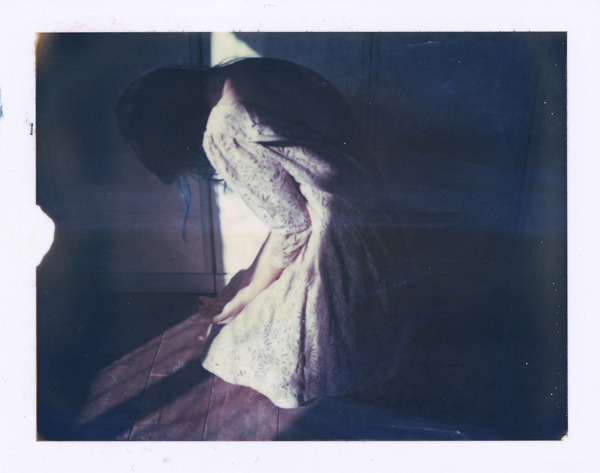
 Her work has been exhibited at international art fairs and festivals in London and Milan.
See more work here on her website.
Her work has been exhibited at international art fairs and festivals in London and Milan.
See more work here on her website.
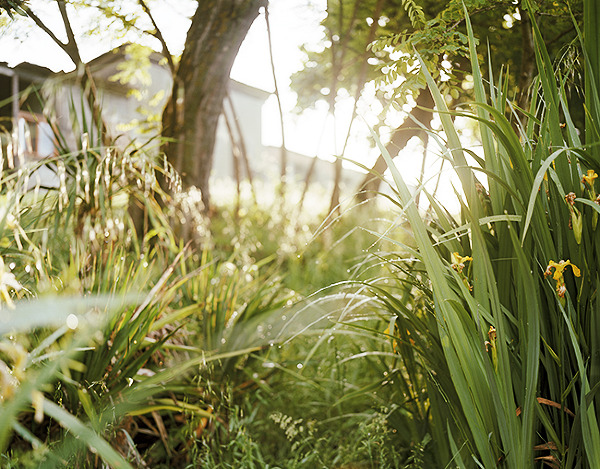 Plantlife, 2010
Michael Powers’ images create a visual narrative of the Hallewell family. Leaving their comfortable life in England to travel to the South of France in search of ‘home’, they returned to their deteriorated family farmhouse. With the help of friendly neighbors and volunteers, life returns to the land and new harvests are created.
Plantlife, 2010
Michael Powers’ images create a visual narrative of the Hallewell family. Leaving their comfortable life in England to travel to the South of France in search of ‘home’, they returned to their deteriorated family farmhouse. With the help of friendly neighbors and volunteers, life returns to the land and new harvests are created.
 From Above, 2010
From Above, 2010 Stuart, 2011
Stuart, 2011 Harmonie, 2011
Harmonie, 2011 Louisa, 2011
The photographs, though taken in the present, record the past. Relationships between images reveal multiplicities of history: the history of the land and the structures upon it, of the documented story and of the photographic medium itself. Through careful sequencing and pacing, the links between images advance a narrative while referencing the history of image-making.
Moving between portraits, still-lives and landscapes, cascading light functions as a unifying element. Tracing the blades of grass in a field and the curving neck of a slaughtered duck, the use of light borrows from the aesthetics of Dutch genre painting, chronicling the everyday. Just as William Henry Fox-Talbot drew this history in his images comrpising The Pencil of Nature, Powers make reference to the beginning of photography, creating equivalences between image-types. The resultant photographs expose the history of the land through the history of visual description.
Louisa, 2011
The photographs, though taken in the present, record the past. Relationships between images reveal multiplicities of history: the history of the land and the structures upon it, of the documented story and of the photographic medium itself. Through careful sequencing and pacing, the links between images advance a narrative while referencing the history of image-making.
Moving between portraits, still-lives and landscapes, cascading light functions as a unifying element. Tracing the blades of grass in a field and the curving neck of a slaughtered duck, the use of light borrows from the aesthetics of Dutch genre painting, chronicling the everyday. Just as William Henry Fox-Talbot drew this history in his images comrpising The Pencil of Nature, Powers make reference to the beginning of photography, creating equivalences between image-types. The resultant photographs expose the history of the land through the history of visual description.
 Death, 2011
Death, 2011 Morning Rise, 2010
Morning Rise, 2010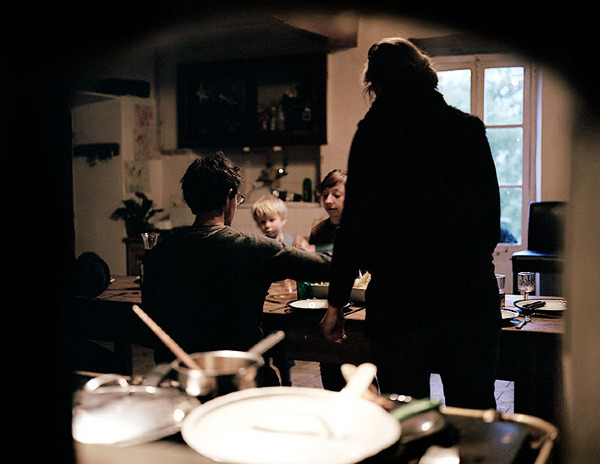
 Harmonie and Phoenix, 2010
Harmonie and Phoenix, 2010 Cockerel, 2010
Cockerel, 2010 Tosca, 2011
Tosca, 2011 Talk , 2012
Talk , 2012 Night Watch, 2011
For more information, please visit Michael’s website
Feature by Sarah Pollman. Sarah is an artist and writer living and working in Boston, MA. She is a current MFA candidate at the School of the Museum of Fine Arts, Boston and Tufts University with an emphasis on photographic history and theory. She is the founder and curator of 3200K, a printed fine-art quarterly dedicated to emerging photographers working in analog media. Her photographs have been shown, published and included in corporate and private collections across the United States.
Night Watch, 2011
For more information, please visit Michael’s website
Feature by Sarah Pollman. Sarah is an artist and writer living and working in Boston, MA. She is a current MFA candidate at the School of the Museum of Fine Arts, Boston and Tufts University with an emphasis on photographic history and theory. She is the founder and curator of 3200K, a printed fine-art quarterly dedicated to emerging photographers working in analog media. Her photographs have been shown, published and included in corporate and private collections across the United States.
 interest income comparison 4% - 8%
He has received numerous awards and prizes including the HSBC Fundation for Photography Prize, the No-Limit Prize of the International Festival of Arles (France), first prize by Paris photo and BMW in 2006, and the Arcimboldo prize for Digital Photography in 2009. His work has been exhibited across Europe, the United States and Asia, and belongs in both private and public collections such as the Musée Nicéphore Niépce (F), Musée de l’Elysée (CH), and Fonds National pour l’Art contemporain (F).
Mathieu Bernard-Reymond is a member of the transcontinental network of photographers Piece Of Cake and was featured in the fourth issue of Aint-Bad Magazine.
interest income comparison 4% - 8%
He has received numerous awards and prizes including the HSBC Fundation for Photography Prize, the No-Limit Prize of the International Festival of Arles (France), first prize by Paris photo and BMW in 2006, and the Arcimboldo prize for Digital Photography in 2009. His work has been exhibited across Europe, the United States and Asia, and belongs in both private and public collections such as the Musée Nicéphore Niépce (F), Musée de l’Elysée (CH), and Fonds National pour l’Art contemporain (F).
Mathieu Bernard-Reymond is a member of the transcontinental network of photographers Piece Of Cake and was featured in the fourth issue of Aint-Bad Magazine.
 technical analysis: Japanese candlesticks
Mathieu's images are other-worldly. Colossal monuments loom quietly in the landscape; eerily reminiscent of the broken industrial complex. He seamlessly integrates constructions into the landscape, drawing the viewer in to examine and further discover it's idiosyncrasies. Titles expose an alternative agenda—unobtrusively questioning our built and natural environment through the eyes of capital agenda.
technical analysis: Japanese candlesticks
Mathieu's images are other-worldly. Colossal monuments loom quietly in the landscape; eerily reminiscent of the broken industrial complex. He seamlessly integrates constructions into the landscape, drawing the viewer in to examine and further discover it's idiosyncrasies. Titles expose an alternative agenda—unobtrusively questioning our built and natural environment through the eyes of capital agenda.
 MBR: I have been working on this project since 2005. I use financial charts and statistics as basic shapes to produce photographic representations of global economic and ecological concerns. The charts have been modeled using 3D software and are then integrated into my landscape photographs. By turning these curves and sculptural shapes into massive constructions—close to memorials, monumental structures—I intend to reach something beyond data. My purpose is to underline their fundamental link to landscape and thus, to human and natural history.
MBR: I have been working on this project since 2005. I use financial charts and statistics as basic shapes to produce photographic representations of global economic and ecological concerns. The charts have been modeled using 3D software and are then integrated into my landscape photographs. By turning these curves and sculptural shapes into massive constructions—close to memorials, monumental structures—I intend to reach something beyond data. My purpose is to underline their fundamental link to landscape and thus, to human and natural history.
 crude oil prices 2003-2008
crude oil prices 2003-2008 cost data for wind turbines and solar modules
cost data for wind turbines and solar modules UBS five year backdrop
UBS five year backdrop schedule of investments 6/30/05
schedule of investments 6/30/05 exxon mobil 9am to 11am
exxon mobil 9am to 11am air and water pollution 2001 and 2006
air and water pollution 2001 and 2006 riskpremium expected return on capital 5yr moving average
riskpremium expected return on capital 5yr moving average scope evaluation activity
scope evaluation activity total operating profit
total operating profit your investment can only grow
your investment can only grow demographic development Sweden 1970-2050
demographic development Sweden 1970-2050 DOW index futures
DOW index futures investment focus-growth
investment focus-growth technical analysis : Elliott waves standard cycle
Click here to visit his website.
technical analysis : Elliott waves standard cycle
Click here to visit his website.
 In 2005, Muge started his project Going Home, documenting the displacement and upheaval caused by the Three Gorges Dam project along the Yangtze River—on his way back home. Five years later, feeling lost in the changes of the Three Gorges, Muge turns to nature—searching for an answer—and continues to explore the balance between man and nature.
In 2005, Muge started his project Going Home, documenting the displacement and upheaval caused by the Three Gorges Dam project along the Yangtze River—on his way back home. Five years later, feeling lost in the changes of the Three Gorges, Muge turns to nature—searching for an answer—and continues to explore the balance between man and nature.
 JD: You studied Television Directing in college. Why did you choose photography, the still form, as your way of expression?
M: I chose the still form back then because making a moving image requires a team. It takes time for the team to fit together, which will affect the initial state of thinking. Photography fits better with my need for personal thinking. It is more experimental and is closer to my current state.
JD: When and how did you start the Ash series? Is it a continuous journey from your earlier projects or is it completely new?
M: 2009 marked the fifth year of my Going Home series. I feel there is less and less to capture in the Three Gorges area. Redundant scenes appear in front of my lens. I went back to my hometown to take a break and figure out a way to continue. During the five years, the changes of the Three Gorges made everything seem strange and uncertain to me. I couldn’t find myself. Is it the change of reality or is it the way the Three Gorges was? I went to different regions to find my answers. Ash initially captures and shows the helplessness—smallness—of individuals in front of reality, thereby reflecting the people’s powerlessness and disorder in the rapid development of contemporary China.
JD:You told me the title “Ash” came from the prayer: “we commit his body to the ground; earth to earth; ashes to ashes, dust to dust.” What do you want to express by using the word “Ash?” And why do you choose “ash” instead of “dust?”
M: In reality, everything becomes ashes in front of the desire of human beings, while dust is a state of matter, an individual.
JD: You studied Television Directing in college. Why did you choose photography, the still form, as your way of expression?
M: I chose the still form back then because making a moving image requires a team. It takes time for the team to fit together, which will affect the initial state of thinking. Photography fits better with my need for personal thinking. It is more experimental and is closer to my current state.
JD: When and how did you start the Ash series? Is it a continuous journey from your earlier projects or is it completely new?
M: 2009 marked the fifth year of my Going Home series. I feel there is less and less to capture in the Three Gorges area. Redundant scenes appear in front of my lens. I went back to my hometown to take a break and figure out a way to continue. During the five years, the changes of the Three Gorges made everything seem strange and uncertain to me. I couldn’t find myself. Is it the change of reality or is it the way the Three Gorges was? I went to different regions to find my answers. Ash initially captures and shows the helplessness—smallness—of individuals in front of reality, thereby reflecting the people’s powerlessness and disorder in the rapid development of contemporary China.
JD:You told me the title “Ash” came from the prayer: “we commit his body to the ground; earth to earth; ashes to ashes, dust to dust.” What do you want to express by using the word “Ash?” And why do you choose “ash” instead of “dust?”
M: In reality, everything becomes ashes in front of the desire of human beings, while dust is a state of matter, an individual.

 JD: Does the Ash series experience emotional changes?
M: Yes. The sense of powerlessness after the Going Home series and the strangeness of my hometown made me extremely frustrated. Therefore I capture the state of individuals in reality. There was no hope in sight. Although the Three Gorges Dam Project gave people some hope, they are just unknowns.
The birth and love of my daughter—her innocent curiosity towards the world—has triggered a renewed willingness to explore life once again. Along with my mother’s faith, recognizing the trace that time leaves on nature and history has opened a window for me to understand reality in a new way. Since then, I’ve observed daily life slowly, “loving” this world instead of “ridiculing” it. I used to see the world with anger, considering everything in a negative light. Now, I like to watch things. Everything exists as it is. It is a simple world.
JD: Does the Ash series experience emotional changes?
M: Yes. The sense of powerlessness after the Going Home series and the strangeness of my hometown made me extremely frustrated. Therefore I capture the state of individuals in reality. There was no hope in sight. Although the Three Gorges Dam Project gave people some hope, they are just unknowns.
The birth and love of my daughter—her innocent curiosity towards the world—has triggered a renewed willingness to explore life once again. Along with my mother’s faith, recognizing the trace that time leaves on nature and history has opened a window for me to understand reality in a new way. Since then, I’ve observed daily life slowly, “loving” this world instead of “ridiculing” it. I used to see the world with anger, considering everything in a negative light. Now, I like to watch things. Everything exists as it is. It is a simple world.


 JD: Do you feel differently when you photograph still life and landscape? And do you photograph them in different ways?
M: Time leaves traces in my heart. When I photograph the landscape, I mainly choose the most unchangeable elements of nature: mountains, water and rocks. However, everything tends to change easily in front of human desire.
When I photograph still life and landscape, I put them in an independent space to perceive their presences.
JD: It seems that you are looking for an essence and eternity in constant change. Is place and time meaningful to you?
M: I think the change you mention is in the heart. It will not change with place or time.
Time is meaningful to me, because the trace of time is part of my work. Place is not important. The photograph itself will get rid of people’s preference of a place. My only hope is that places exist independently, mountains as mountains, rocks as rocks, water as water...I am influenced a lot by Taoism, caring for nature as it is. However, objects of nature change with people’s feelings.
JD: Do you feel differently when you photograph still life and landscape? And do you photograph them in different ways?
M: Time leaves traces in my heart. When I photograph the landscape, I mainly choose the most unchangeable elements of nature: mountains, water and rocks. However, everything tends to change easily in front of human desire.
When I photograph still life and landscape, I put them in an independent space to perceive their presences.
JD: It seems that you are looking for an essence and eternity in constant change. Is place and time meaningful to you?
M: I think the change you mention is in the heart. It will not change with place or time.
Time is meaningful to me, because the trace of time is part of my work. Place is not important. The photograph itself will get rid of people’s preference of a place. My only hope is that places exist independently, mountains as mountains, rocks as rocks, water as water...I am influenced a lot by Taoism, caring for nature as it is. However, objects of nature change with people’s feelings.

 JD: Can you tell us more about your conceptual and artistic influences?
M: Lao Tzu’s philosophy on nature influences me a lot. As for art, I am influenced by the traditional Chinese literati paintings and the reflection of personal experiences in traditional Chinese Shanshui landscape painting. The exploration of nature in 17th Century Dutch painting school has also influenced my work. However, it is life that helps me understand the state of reality.
JD: What do you think is the best way to present your work?
M: A photobook is the most ideal way. I am going to put my work and my thought into a hand-make photo book in order to present my process of thinking. I believe that will be very interesting. A good exhibition space is ideal as well. Ash brings objects in nature to a simple space, inviting the viewers to experience the work by themselves.
JD: Can you tell us more about your conceptual and artistic influences?
M: Lao Tzu’s philosophy on nature influences me a lot. As for art, I am influenced by the traditional Chinese literati paintings and the reflection of personal experiences in traditional Chinese Shanshui landscape painting. The exploration of nature in 17th Century Dutch painting school has also influenced my work. However, it is life that helps me understand the state of reality.
JD: What do you think is the best way to present your work?
M: A photobook is the most ideal way. I am going to put my work and my thought into a hand-make photo book in order to present my process of thinking. I believe that will be very interesting. A good exhibition space is ideal as well. Ash brings objects in nature to a simple space, inviting the viewers to experience the work by themselves.

 JD: How do you edition your work?
M: There is only one size and the work is in an edition of 8. I want to give each piece a complete presentation instead of focusing on sales.
There is also a special collector’s edition with edition of 10. Each edition has 12 silver gelatin prints placed in a special made wooden box. They are like ancient Chinese scrolls, which have a taste of reading beyond appreciation.
JD: Your works has been exhibited in China as well as abroad. Do the Chinese and western audiences have different responses toward your works?
M: From Going Home to Ash, my works arouse more attention abroad than in China. Western audiences value individual expressions, while Chinese audiences pay more attention to the freshness and uniqueness of events. My works is based on individuals and is a reflection on the present.
JD: How do you edition your work?
M: There is only one size and the work is in an edition of 8. I want to give each piece a complete presentation instead of focusing on sales.
There is also a special collector’s edition with edition of 10. Each edition has 12 silver gelatin prints placed in a special made wooden box. They are like ancient Chinese scrolls, which have a taste of reading beyond appreciation.
JD: Your works has been exhibited in China as well as abroad. Do the Chinese and western audiences have different responses toward your works?
M: From Going Home to Ash, my works arouse more attention abroad than in China. Western audiences value individual expressions, while Chinese audiences pay more attention to the freshness and uniqueness of events. My works is based on individuals and is a reflection on the present.



 JD: Do you consider the Ash series completed? How do you decide whether a body of work is completed?
M: Ash is like the practice of life, which has no end. Ash is not about telling a story. It reflects my thought on human and nature. It should be only the end of a certain period.
Only once the work has lost the initial confusion and becomes redundant, will I know to call it an end.
JD: What’s your next step?
M: I will work on expanding the Ash series, exploring the representation of the spiritual core.
For more information visit Muge's website.
Zhenjie Dong is a Chinese born and New York based artist and photographer exploring ways to express her social and political concerns through photography. She spoke at TEDxCreative Coast 2012 about her work Recreating Myth and the philosophy behind it. Her works have been exhibited in the Atlanta Photography Group Gallery, the North Carolina Museum of Art, and will join the global tour of the Lumen Prize Exhibition, travelling around the world in United Kingdom, Latvia, China and Wales.
JD: Do you consider the Ash series completed? How do you decide whether a body of work is completed?
M: Ash is like the practice of life, which has no end. Ash is not about telling a story. It reflects my thought on human and nature. It should be only the end of a certain period.
Only once the work has lost the initial confusion and becomes redundant, will I know to call it an end.
JD: What’s your next step?
M: I will work on expanding the Ash series, exploring the representation of the spiritual core.
For more information visit Muge's website.
Zhenjie Dong is a Chinese born and New York based artist and photographer exploring ways to express her social and political concerns through photography. She spoke at TEDxCreative Coast 2012 about her work Recreating Myth and the philosophy behind it. Her works have been exhibited in the Atlanta Photography Group Gallery, the North Carolina Museum of Art, and will join the global tour of the Lumen Prize Exhibition, travelling around the world in United Kingdom, Latvia, China and Wales.
 Mummers have been a tradition in Newfoundland, Canada, since the beginning of the seventeenth century. Mummer comes from the old French ‘momer’ which means to wear a mask. Fishermen would disguise themselves with old clothing and cover their faces and go from house to house in their community during the twelve nights of Christmas. When the householder responds to the mummers’ tapping on the door, the visitors using disguised voices ask, “Any mummers ‘lowed in?” Once granted entrance, music is played and rum is drunk, the Mummers move from house to house during the 12 days leading up to Christmas. If they are welcomed in, they usually entertain their hosts with humorous antics and the musical instruments they carry, very often a fiddle. Hosts offer rum and serve cake or other sweets. A great guessing game ensues as the hosts try to guess the identities of the mummers. When correctly identified, the revellers remove their masks, but if not identified, they keep them on.
Mummers have been a tradition in Newfoundland, Canada, since the beginning of the seventeenth century. Mummer comes from the old French ‘momer’ which means to wear a mask. Fishermen would disguise themselves with old clothing and cover their faces and go from house to house in their community during the twelve nights of Christmas. When the householder responds to the mummers’ tapping on the door, the visitors using disguised voices ask, “Any mummers ‘lowed in?” Once granted entrance, music is played and rum is drunk, the Mummers move from house to house during the 12 days leading up to Christmas. If they are welcomed in, they usually entertain their hosts with humorous antics and the musical instruments they carry, very often a fiddle. Hosts offer rum and serve cake or other sweets. A great guessing game ensues as the hosts try to guess the identities of the mummers. When correctly identified, the revellers remove their masks, but if not identified, they keep them on.
 This work is part Hallberg-Campbell's ongoing book length project 'Coastal'. Coastal communities had lived off the sea for centuries. They are diminishing year after year as more and more young people leave their home and heritage to find work. The fishing industry is not what it once was: the communities have seen the erosion and the end of their culture as large fishing draggers and fish factories continue to dominate. Coastal and island communities dependent on the ocean and traditional fishing are being swallowed up by the modern world.
This work is part Hallberg-Campbell's ongoing book length project 'Coastal'. Coastal communities had lived off the sea for centuries. They are diminishing year after year as more and more young people leave their home and heritage to find work. The fishing industry is not what it once was: the communities have seen the erosion and the end of their culture as large fishing draggers and fish factories continue to dominate. Coastal and island communities dependent on the ocean and traditional fishing are being swallowed up by the modern world.

 Johan has exhibited his work widely in Canada and Scotland. He was one of five artists selected to show their work at the first international Magenta Flash Forward Festival, (Canadian Exhibit) from his series "Grand Bruit". He has since been selected a 2012 Flash Forward competition winner for emerging photographers for the work 'Coastal', which was also exhibited as a 'Contact Photography Festival Feature Show' at the Toronto Harbourfront Centre. Currently Johan's work can be seen on billboards at the waterfront in Toronto as the group outdoor show (Uncharted Waters) commissioned by the Toronto Port Authority.
Mummer
Johan has exhibited his work widely in Canada and Scotland. He was one of five artists selected to show their work at the first international Magenta Flash Forward Festival, (Canadian Exhibit) from his series "Grand Bruit". He has since been selected a 2012 Flash Forward competition winner for emerging photographers for the work 'Coastal', which was also exhibited as a 'Contact Photography Festival Feature Show' at the Toronto Harbourfront Centre. Currently Johan's work can be seen on billboards at the waterfront in Toronto as the group outdoor show (Uncharted Waters) commissioned by the Toronto Port Authority.
Mummer




 {image 27
{image 27 }
}


 He has photographed, been published and curated for publications and institutions such as: Canadian Red Cross, The Walrus, Canadian Art, The Big Issue, Scots Magazine, Pikto, VII Gallery, Report on Business, Globe and Mail, CTV, The Grid, Toronto Star, Toronto Magazine, Toronto Tourism, The Harbourfront Centre and House of Anansi. Johan has worked alongside fellow photographers having curated over 40 gallery shows since 2008 and now continues with his own book length project 'Coastal'.
He has photographed, been published and curated for publications and institutions such as: Canadian Red Cross, The Walrus, Canadian Art, The Big Issue, Scots Magazine, Pikto, VII Gallery, Report on Business, Globe and Mail, CTV, The Grid, Toronto Star, Toronto Magazine, Toronto Tourism, The Harbourfront Centre and House of Anansi. Johan has worked alongside fellow photographers having curated over 40 gallery shows since 2008 and now continues with his own book length project 'Coastal'.
 For more information about Johan and to view his full body of work visit his website.
For more information about Johan and to view his full body of work visit his website.
 Fukushima, Invisible Pain
Within the natural environment and in the areas surrounding cities across Fukushima prefecture, I have captured the invisible pain of radiation. With an ear to the rhythm of the seasons as in traditional Japanese engravings and inspired by their refined, uncluttered style, I hoped to capture the fleeting moments, the movements of climatic phenomena, and the ever-shifting perceptions of nature, where radiation accumulates the most.
Fukushima, Invisible Pain
Within the natural environment and in the areas surrounding cities across Fukushima prefecture, I have captured the invisible pain of radiation. With an ear to the rhythm of the seasons as in traditional Japanese engravings and inspired by their refined, uncluttered style, I hoped to capture the fleeting moments, the movements of climatic phenomena, and the ever-shifting perceptions of nature, where radiation accumulates the most.



 I used a pinhole camera with long exposure times to create a record of the presence of radioactive danger. A dosimeter measured the level of radiation in milliSieverts (μSv) received during each exposure. Each photo is an accumulation of visual fragments taken in the same location but from different angles, always accompanied by the radiation level to which my film was exposed. The result is a combination of all those elements.
I used a pinhole camera with long exposure times to create a record of the presence of radioactive danger. A dosimeter measured the level of radiation in milliSieverts (μSv) received during each exposure. Each photo is an accumulation of visual fragments taken in the same location but from different angles, always accompanied by the radiation level to which my film was exposed. The result is a combination of all those elements.




 A process of staggered superimpression creates a vibration, a departure from the reality of the subject that reveals the presence of radiation in the image. The process reinvents and twists the very landscape, leading to a sort of vertigo or malaise linked to the quivering of the invisible.
My ambition with this project was to find a balance and organization in a chaotic world, while emphasizing the intransience of beauty. I also sought to test the bounds of photography by challenging its ability to render an image of what is invisible to the eye by means of time and distortion.
A process of staggered superimpression creates a vibration, a departure from the reality of the subject that reveals the presence of radiation in the image. The process reinvents and twists the very landscape, leading to a sort of vertigo or malaise linked to the quivering of the invisible.
My ambition with this project was to find a balance and organization in a chaotic world, while emphasizing the intransience of beauty. I also sought to test the bounds of photography by challenging its ability to render an image of what is invisible to the eye by means of time and distortion.


 For more information on Florian Ruiz and to see more of his work please visit his website.
For more information on Florian Ruiz and to see more of his work please visit his website.
 Nearly a kilometer in every direction the desert lay pocked with the remnants of centuries of exploratory excavations by archaeologists, looters, and those who fall somewhere in between. Huts constructed of reed now overlook this barren pit ridden landscape sitting atop concomitant mounds. They serve as second homes for the guards watching over the site.
Nearly a kilometer in every direction the desert lay pocked with the remnants of centuries of exploratory excavations by archaeologists, looters, and those who fall somewhere in between. Huts constructed of reed now overlook this barren pit ridden landscape sitting atop concomitant mounds. They serve as second homes for the guards watching over the site.


 At night coded messages shine from one guard to the next via the flicker of a light. If a threat is suspected, action is taken. The site guards fire off glorified cap guns and flares in hopes of scaring off armed looters, while the monument guards take to more drastic measures of sly action. Once the threat passes, water from an emptied bleach bottle is poured into the kettle already sitting over a fire and over the brewing tea they rest, keeping their eyes out to the night for the next flicker of light.
In the weeks following the start of the revolution, the archaeological team that was meant to work in Abydos for 10 weeks evacuated and the police and military fled. Armed only with walking sticks and quirky scare tactics, the civilian site guards and local villagers were in reality outmatched by gangs of armed looters seeking quick riches. It was only because of their quick action and unusual wit that these men were able to save the site from further plunder.
At night coded messages shine from one guard to the next via the flicker of a light. If a threat is suspected, action is taken. The site guards fire off glorified cap guns and flares in hopes of scaring off armed looters, while the monument guards take to more drastic measures of sly action. Once the threat passes, water from an emptied bleach bottle is poured into the kettle already sitting over a fire and over the brewing tea they rest, keeping their eyes out to the night for the next flicker of light.
In the weeks following the start of the revolution, the archaeological team that was meant to work in Abydos for 10 weeks evacuated and the police and military fled. Armed only with walking sticks and quirky scare tactics, the civilian site guards and local villagers were in reality outmatched by gangs of armed looters seeking quick riches. It was only because of their quick action and unusual wit that these men were able to save the site from further plunder.

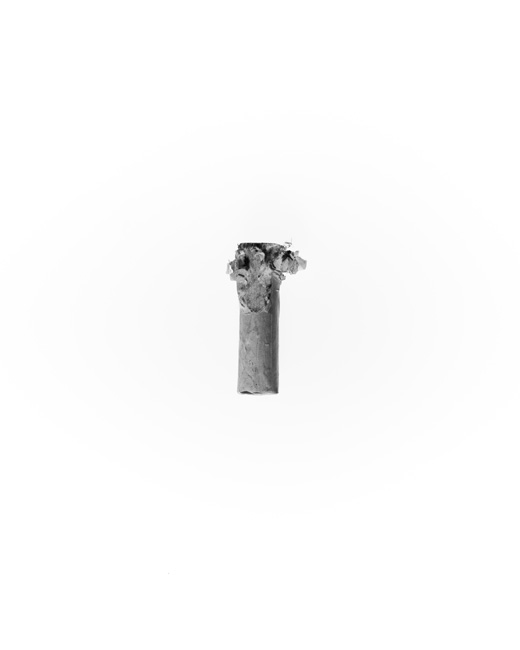
 I first became interested in photography as a form of expression, but having studied the fine arts - having drawn, printed, painted, and sculpted - I realized that photography was a medium that could foster a greater connection to the outside world. Thus photography to me serves as a means for continuing my education and broadening my understanding of that which may surround me. I adhere to the idea that, as John Stilgoe states, "Education ought to work outdoors, in the rain and the sleet, in the knife-like heat of a summertime Nebraska wheat field, along a half-abandoned railroad track on a dark autumn afternoon, on the North Atlantic in winter.” So in a way my photos become my notes.
I first became interested in photography as a form of expression, but having studied the fine arts - having drawn, printed, painted, and sculpted - I realized that photography was a medium that could foster a greater connection to the outside world. Thus photography to me serves as a means for continuing my education and broadening my understanding of that which may surround me. I adhere to the idea that, as John Stilgoe states, "Education ought to work outdoors, in the rain and the sleet, in the knife-like heat of a summertime Nebraska wheat field, along a half-abandoned railroad track on a dark autumn afternoon, on the North Atlantic in winter.” So in a way my photos become my notes.





 Field Season
For more work by Greg Maka, please visit his website.
Field Season
For more work by Greg Maka, please visit his website.














 View more of Mathieu's work at his website
View more of Mathieu's work at his website
 Phantasm is merely a loosely knit collection of photographs. He approaches each image individually, ruminating on a concept for months on end before attempting to capture it. Nease cites celestial daydreaming and visions of the metaphysical dreamscape as inspiration for this process. Phantasm is marked by the spiritual nuance of adventure, indicative of his childhood days getting lost in the woods of South Carolina.
Phantasm is merely a loosely knit collection of photographs. He approaches each image individually, ruminating on a concept for months on end before attempting to capture it. Nease cites celestial daydreaming and visions of the metaphysical dreamscape as inspiration for this process. Phantasm is marked by the spiritual nuance of adventure, indicative of his childhood days getting lost in the woods of South Carolina.

 Nease describes his work as a linear representation of his subconscious. He refers to each photograph as a “breadcrumb trail,” capable of indicating where his mind was at that point in time. He rarely shows features of his subjects in an attempt to humanize his shadowy thoughts. His illusion to the occult is intended to represent Jung’s collective unconscious.
Nease describes his work as a linear representation of his subconscious. He refers to each photograph as a “breadcrumb trail,” capable of indicating where his mind was at that point in time. He rarely shows features of his subjects in an attempt to humanize his shadowy thoughts. His illusion to the occult is intended to represent Jung’s collective unconscious.
 Only 20 years old, Nease’s ability to manipulate film is as calculated as a disciplined photographer. Most photographs in the Phantasm series were taken in darkness, sometimes using glow in the dark paint as a light source. His technique in the dark room is a novice process, which became sophisticated over time by efficacious accidents. After developing a photograph, he will sometimes scan the image, thus producing a physicality of each photograph thanks to the information picked up in the scanner.
Only 20 years old, Nease’s ability to manipulate film is as calculated as a disciplined photographer. Most photographs in the Phantasm series were taken in darkness, sometimes using glow in the dark paint as a light source. His technique in the dark room is a novice process, which became sophisticated over time by efficacious accidents. After developing a photograph, he will sometimes scan the image, thus producing a physicality of each photograph thanks to the information picked up in the scanner.








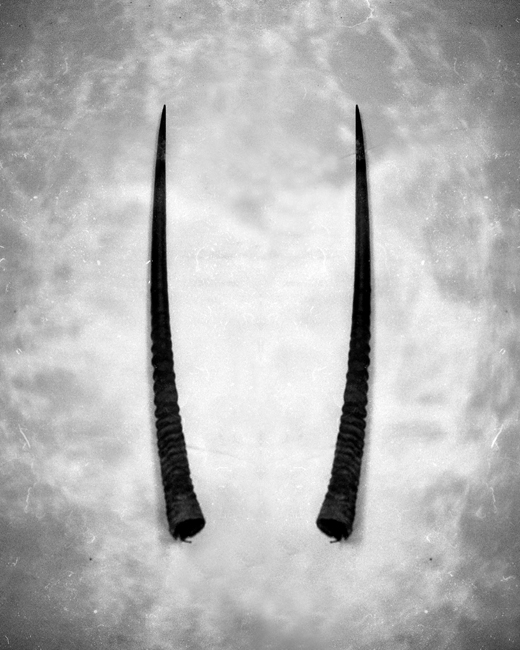

 After a stinted attempt at art school in Chicago, Nease has taken to the “spiritual freedom” of travel. His work continues to explore his surroundings and primitive impulses.
After a stinted attempt at art school in Chicago, Nease has taken to the “spiritual freedom” of travel. His work continues to explore his surroundings and primitive impulses.
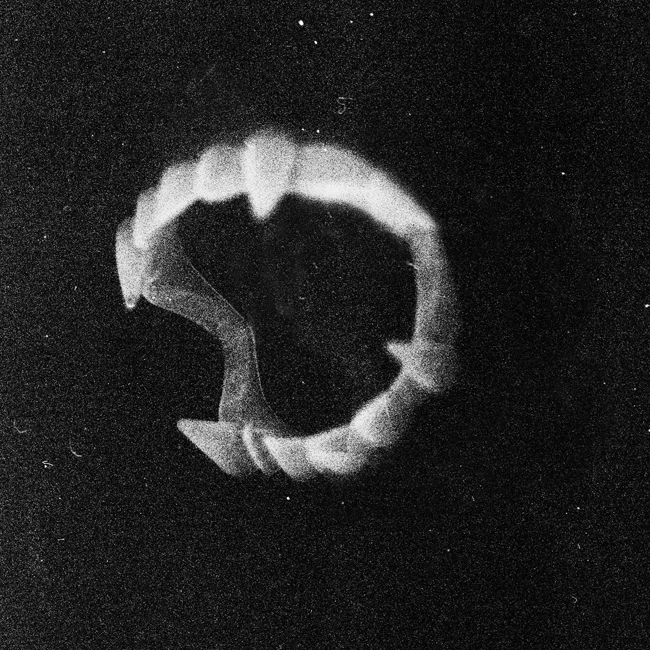 Tommy Nease is a young soul who spends his days traveling the states and abroad. He constantly submerges himself in new surroundings in order to gain inspiration for his photography. Nease’s work shares aesthetic sensibilities with the likes of Man Ray, Roger Ballen and Ryan McGinley. Nease’s work had been both exhibited and published throughout the United States and Europe including collaborations with: Dazed and Confused Magazine (London), Unpublished Magazine (Milan), the FOAM Museum (Amsterdam), RELIC (Brooklyn), N‐SPHERE (Romania), Tell Mum Everything is OK (Paris), among others.
Tommy Nease is a young soul who spends his days traveling the states and abroad. He constantly submerges himself in new surroundings in order to gain inspiration for his photography. Nease’s work shares aesthetic sensibilities with the likes of Man Ray, Roger Ballen and Ryan McGinley. Nease’s work had been both exhibited and published throughout the United States and Europe including collaborations with: Dazed and Confused Magazine (London), Unpublished Magazine (Milan), the FOAM Museum (Amsterdam), RELIC (Brooklyn), N‐SPHERE (Romania), Tell Mum Everything is OK (Paris), among others.  Nease’s solo ventures include PNEUMA a book published by Fourteen Nineteen (London) and Other/Other (USA) with an opening release exhibition at the Happy Dog Gallery in Chicago. His first solo exhibition “EXPLOR/ATIONS” (2010) took place at the Black Sheep Gallery in Charlotte, North Carolina. He recently exhibited PHANTASM at Get This! Gallery in Atlanta, Georgia.
For more of this work, visit his website.
Alexandra Parrish lives and works in Atlanta, GA. She is involved in the Atlanta arts and music scene, but she is most proud of her pizza vixen status. Her writing has been published in Brooklyn Street Art and featured in Huffington Post.
Nease’s solo ventures include PNEUMA a book published by Fourteen Nineteen (London) and Other/Other (USA) with an opening release exhibition at the Happy Dog Gallery in Chicago. His first solo exhibition “EXPLOR/ATIONS” (2010) took place at the Black Sheep Gallery in Charlotte, North Carolina. He recently exhibited PHANTASM at Get This! Gallery in Atlanta, Georgia.
For more of this work, visit his website.
Alexandra Parrish lives and works in Atlanta, GA. She is involved in the Atlanta arts and music scene, but she is most proud of her pizza vixen status. Her writing has been published in Brooklyn Street Art and featured in Huffington Post.
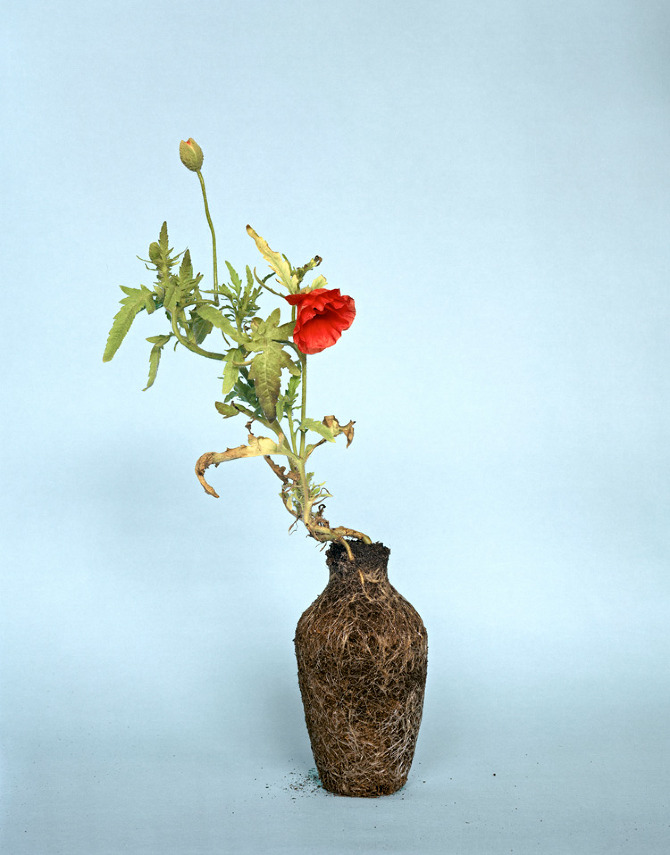
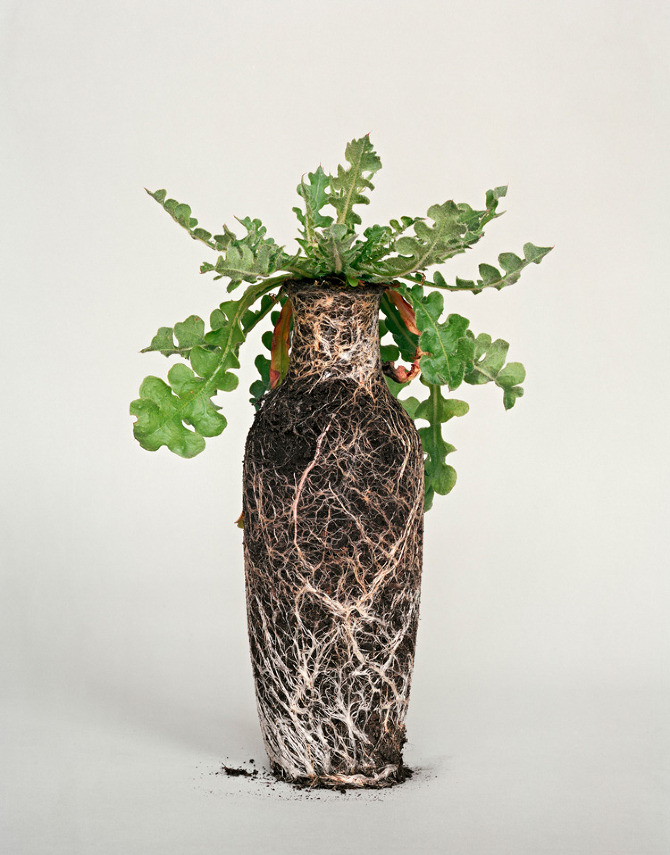 Nature Studies
Rather than letting the flowers grow in open soil, she has forced each plant to develop within the confines of a vase. Only at the end of the process does she remove the plant’s corset, exposing roots that retain their shape as an evoc of the now absent vase.
Nature Studies
Rather than letting the flowers grow in open soil, she has forced each plant to develop within the confines of a vase. Only at the end of the process does she remove the plant’s corset, exposing roots that retain their shape as an evoc of the now absent vase.
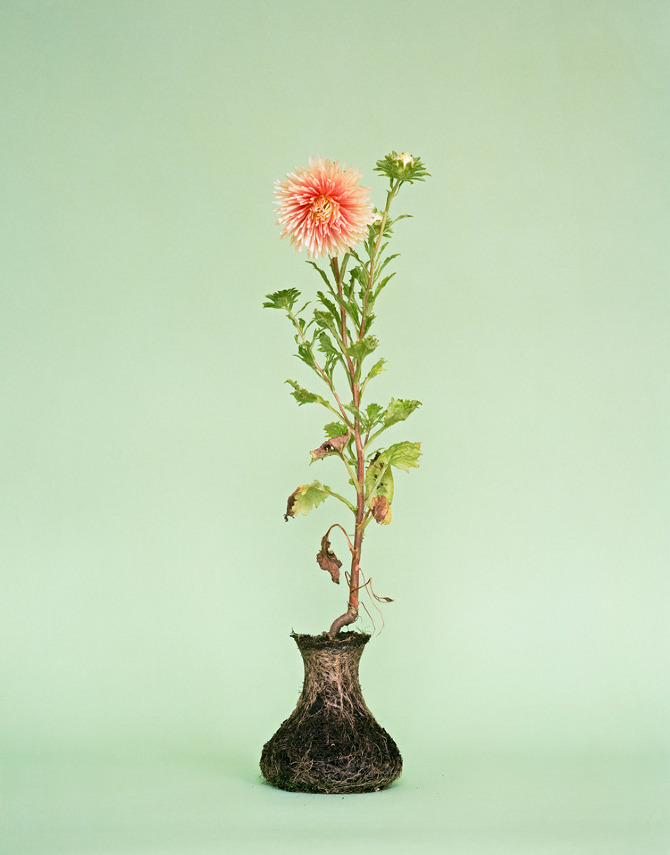
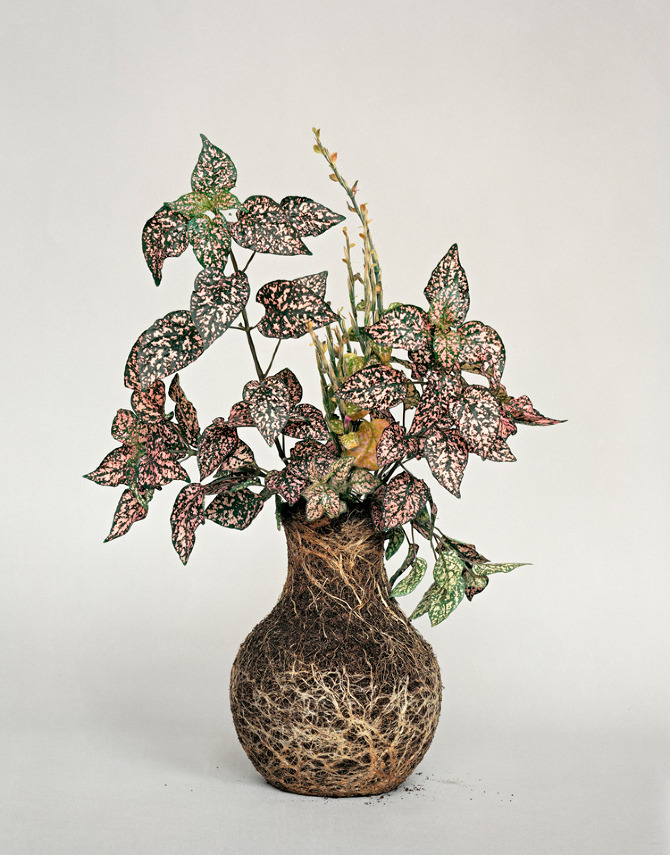 There is an inherent contradiction in Scherer’s working method. Although she is dedicated to the project and keeps a close eye on whether the roots are developing as desired—checking them carefully and with the utmost precision—her ability to manipulate the plants’ growth is limited. She has to accept the impossibility of total control. This contrast between almost obsessive monitoring and an inability to fundamentally influence events becomes an intense, almost ritual presence in her work. Scherer’s photos are carefully rationed, showing a single moment as the culmination of a long process of growth. She documents the flowers at their peak, just before they begin to shrivel as the plants start to die.
There is an inherent contradiction in Scherer’s working method. Although she is dedicated to the project and keeps a close eye on whether the roots are developing as desired—checking them carefully and with the utmost precision—her ability to manipulate the plants’ growth is limited. She has to accept the impossibility of total control. This contrast between almost obsessive monitoring and an inability to fundamentally influence events becomes an intense, almost ritual presence in her work. Scherer’s photos are carefully rationed, showing a single moment as the culmination of a long process of growth. She documents the flowers at their peak, just before they begin to shrivel as the plants start to die.
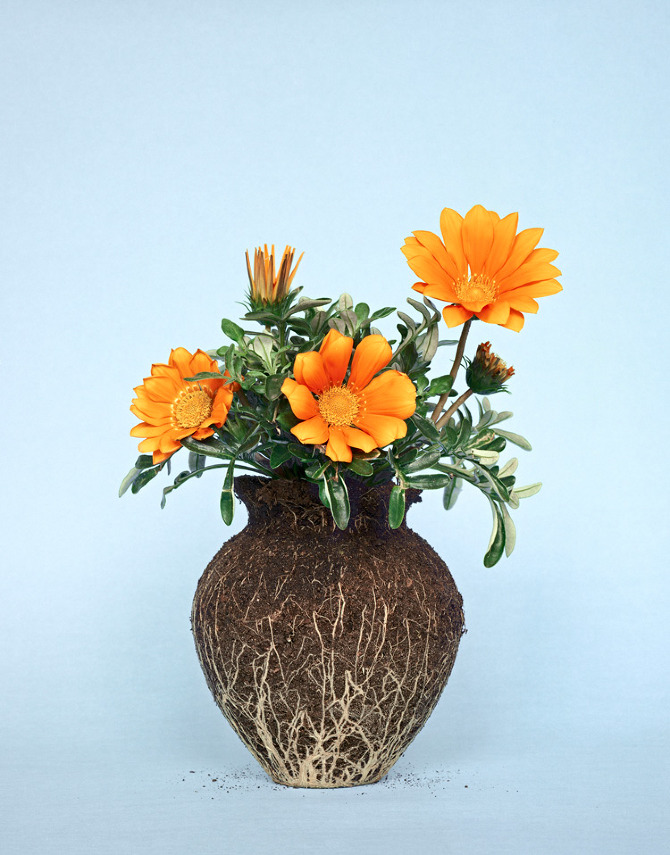
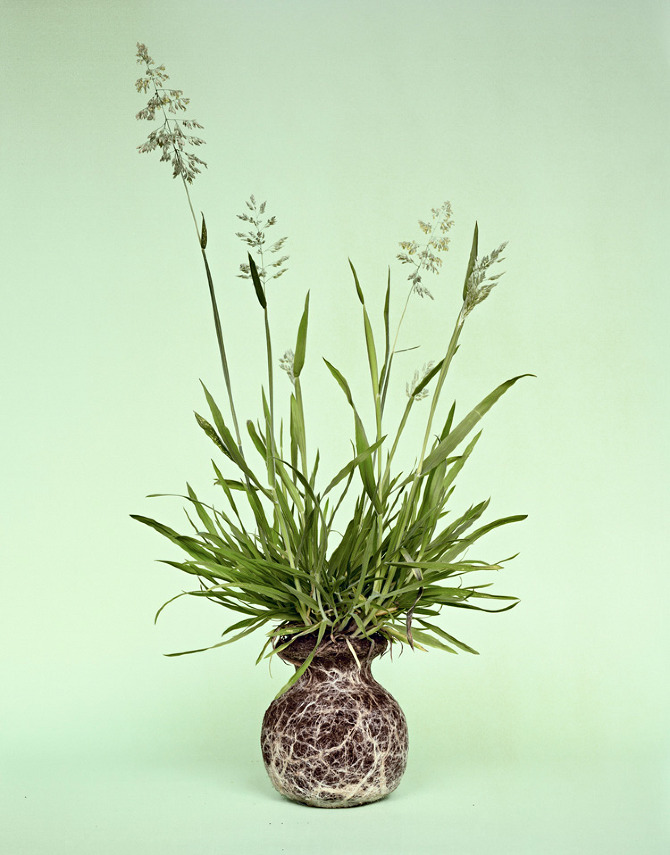 The photos Scherer has produced for Nurture Studies recall the illustrations in seventeenth-century botanical encyclopaedias, which presented flowers roots and all. Her work also has strong similarities with 1970s plant books, in which indoor plants were often arranged on a pedestal and set off with fabrics that added a romantic touch to the whole. Although clearly referring to these predecessors, Scherer has no difficulty avoiding the perceived cosiness of the “pot plant” genre. Her images are bare, unadorned. The careful observer will notice that most of the plants are anything but perfect specimens. Brown edges and broken stems show that mortality is already making its presence felt. The pink aster’s leaves are already dying off and other plants, dandelion and cow parsley for instance, wouldn’t be deemed worthy of a second glance on the side of the road. Scherer treats them all as equals.
The photos Scherer has produced for Nurture Studies recall the illustrations in seventeenth-century botanical encyclopaedias, which presented flowers roots and all. Her work also has strong similarities with 1970s plant books, in which indoor plants were often arranged on a pedestal and set off with fabrics that added a romantic touch to the whole. Although clearly referring to these predecessors, Scherer has no difficulty avoiding the perceived cosiness of the “pot plant” genre. Her images are bare, unadorned. The careful observer will notice that most of the plants are anything but perfect specimens. Brown edges and broken stems show that mortality is already making its presence felt. The pink aster’s leaves are already dying off and other plants, dandelion and cow parsley for instance, wouldn’t be deemed worthy of a second glance on the side of the road. Scherer treats them all as equals.
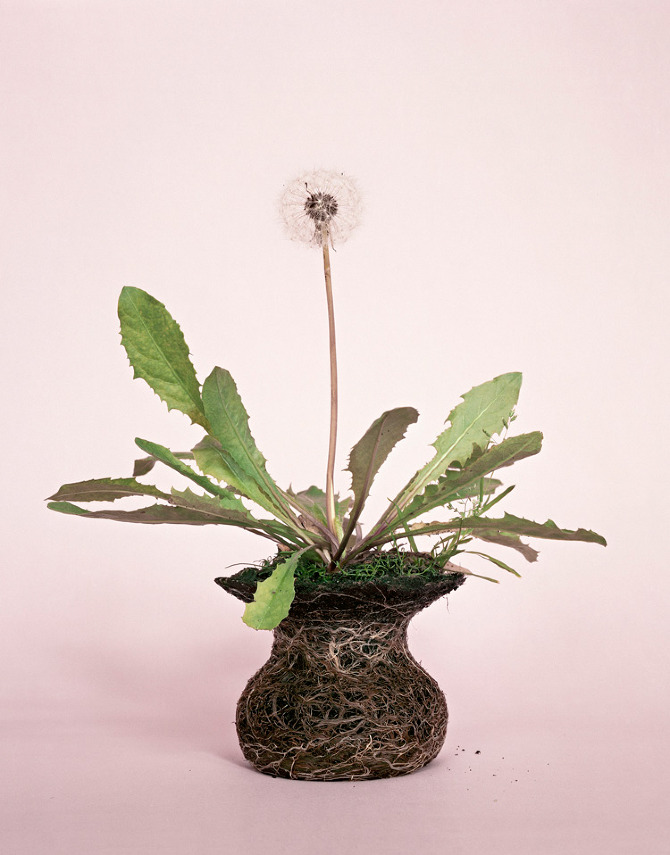
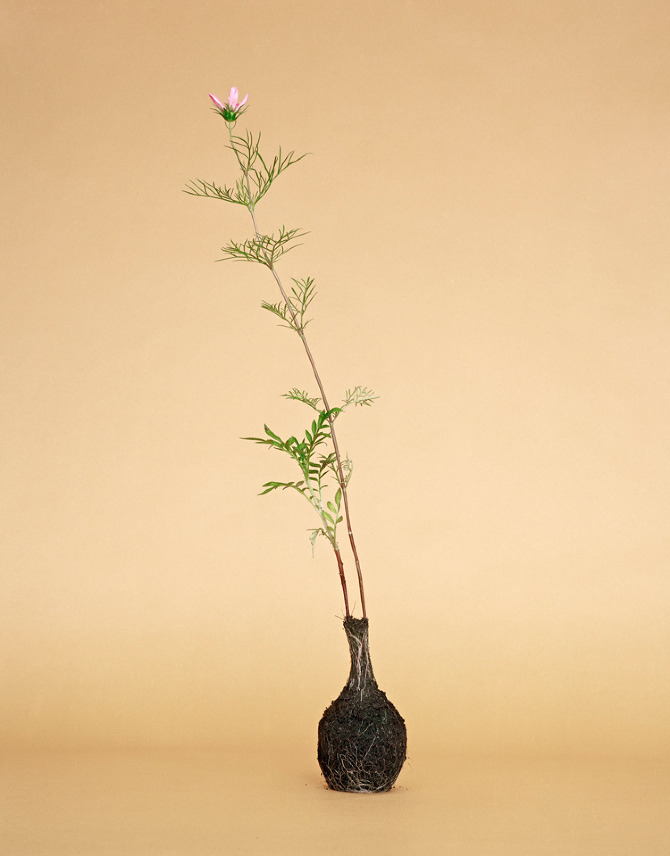 The floral portraits form a pendant to earlier photo series in which Scherer opted for much rawer imagery, things like young girls lying on the ground with their backs to the camera, collapsed like rag dolls, so that viewers almost automatically think of them as victims (Mädchen, 2002–2007). In Nurture Studies this confrontational imagery has made way for subtlety. Although the flowers, with their exposed roots, look just as fragile as the girls, Scherer avoids any semblance of drama, mainly by the objectivity of her photographic style, arranging the plants upright in the frame and photographing them with a technical camera. This approach is consistent with the orderly way collectors catalogue their objects.
The floral portraits form a pendant to earlier photo series in which Scherer opted for much rawer imagery, things like young girls lying on the ground with their backs to the camera, collapsed like rag dolls, so that viewers almost automatically think of them as victims (Mädchen, 2002–2007). In Nurture Studies this confrontational imagery has made way for subtlety. Although the flowers, with their exposed roots, look just as fragile as the girls, Scherer avoids any semblance of drama, mainly by the objectivity of her photographic style, arranging the plants upright in the frame and photographing them with a technical camera. This approach is consistent with the orderly way collectors catalogue their objects.
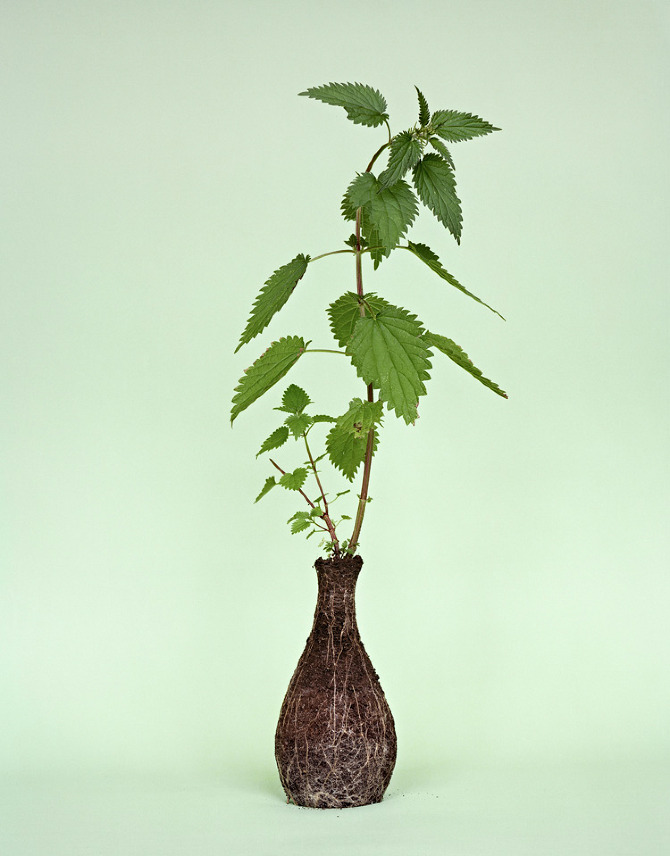 Diana’s work has been published widely in Capricious, The New Yorker Blog, Liberation and Blink Magazine. Her work was presented in solo and group exhibitions in Paris, New York, Berlin and Seoul. In 2008, Diana received the Gregers Nielsen Award by the Brandts Museum of Photography in Denmark and was nominated for the Festival International de Mode et de Photographie. In 2011, she was awarded second place of the Bouw in Beeldprijs in the Netherlands.
To view more of Diana's work please visit her website.
Highlight by Taylor Curry
Diana’s work has been published widely in Capricious, The New Yorker Blog, Liberation and Blink Magazine. Her work was presented in solo and group exhibitions in Paris, New York, Berlin and Seoul. In 2008, Diana received the Gregers Nielsen Award by the Brandts Museum of Photography in Denmark and was nominated for the Festival International de Mode et de Photographie. In 2011, she was awarded second place of the Bouw in Beeldprijs in the Netherlands.
To view more of Diana's work please visit her website.
Highlight by Taylor Curry
 Center Peak #1
Center Peak #1 Kern Divide
Darkness in the Range of Light (2012)
This series was created during a 221-mile solo hike across the Sierra Nevada mountain range in the state of California . These photos attempt to communicate the psychological shift that occurs when the Sun disappears.
Kern Divide
Darkness in the Range of Light (2012)
This series was created during a 221-mile solo hike across the Sierra Nevada mountain range in the state of California . These photos attempt to communicate the psychological shift that occurs when the Sun disappears.
 Black Divide
Black Divide Palisades
Palisades Cloud's Rest
Cloud's Rest Center Peak #2
Center Peak #2 Seven Gables
Seven Gables Mount Whitney
Mount Whitney Goddard Divide
Goddard Divide Kuna Crest
Cody's photographs have appeared in such publications as Holy Ghost Zine, If You Leave, Humanize and 16HOURS. His work has also been featured online by Dazed Digital, Booooooom, Tiny Waves, Portable.tv and NeverLazy.
To see more of Cody's work please visit his website.
Highlight by Taylor Curry
Kuna Crest
Cody's photographs have appeared in such publications as Holy Ghost Zine, If You Leave, Humanize and 16HOURS. His work has also been featured online by Dazed Digital, Booooooom, Tiny Waves, Portable.tv and NeverLazy.
To see more of Cody's work please visit his website.
Highlight by Taylor Curry


 Dubailand 2008
Aleix Plademunt’s approach to landscape is rooted in his reading of the signs and symbols he encounters. His reading is careful and detailed and centres on the action of man and its relationship to landscape. In that sense, Dubai appears as a very symptomatic place that is quite transparent about the social and ideological characteristics that have determined the artificial construction of its landscapes. Since such processes are happening all throughout the world, increasingly melting the idiosyncrasy of previously different cities in one single mode, the core reflection in Dubailand, as in many other projects by Plademunt, does not deal so much with topos, about the place, as much as about its process of dissolution. And thus, it is about the difficulty to keep reading and talking this universal language that Plademunt considers as the mother tongue that constitutes landscape or what he describes as our first way of communication before the first signs and symbols. Maybe his projects also talk about the need to finally assume what the symptomatic landscape of Dubai has to say about us.
Marta Dahó
Dubailand 2008
Aleix Plademunt’s approach to landscape is rooted in his reading of the signs and symbols he encounters. His reading is careful and detailed and centres on the action of man and its relationship to landscape. In that sense, Dubai appears as a very symptomatic place that is quite transparent about the social and ideological characteristics that have determined the artificial construction of its landscapes. Since such processes are happening all throughout the world, increasingly melting the idiosyncrasy of previously different cities in one single mode, the core reflection in Dubailand, as in many other projects by Plademunt, does not deal so much with topos, about the place, as much as about its process of dissolution. And thus, it is about the difficulty to keep reading and talking this universal language that Plademunt considers as the mother tongue that constitutes landscape or what he describes as our first way of communication before the first signs and symbols. Maybe his projects also talk about the need to finally assume what the symptomatic landscape of Dubai has to say about us.
Marta Dahó









 To view more of Plademunt's work please visit his website.
Highlight by Taylor Curry
To view more of Plademunt's work please visit his website.
Highlight by Taylor Curry
 This series of images is inherently geometric and have a soft spoken way about them. Using the frame to break the image plane into sections and color blocks, he organizes the potentially chaotic. He focus on manmade constructs, dissecting the objects interaction with its immediate environment—resulting in infinite image combinations.
This series of images is inherently geometric and have a soft spoken way about them. Using the frame to break the image plane into sections and color blocks, he organizes the potentially chaotic. He focus on manmade constructs, dissecting the objects interaction with its immediate environment—resulting in infinite image combinations.











 You can see more of this project on his blog.
You can see more of this project on his blog.

 Zhang Xiao artist statement : THEY
This is not a real world, though I like them. In a moment, they surpass themselves in reality just like sleepwalking. I seldom talked to them when I shot them, or only made eye contacts with them. Most of the time, I pressed the shutter quickly, with the dazzling flash shooting at right angles. When they awoke and stared at me, I already left in a hurry, because I didn’t dare to look into their eyes. I escaped, just like escaping from myself in the mirror.
Zhang Xiao artist statement : THEY
This is not a real world, though I like them. In a moment, they surpass themselves in reality just like sleepwalking. I seldom talked to them when I shot them, or only made eye contacts with them. Most of the time, I pressed the shutter quickly, with the dazzling flash shooting at right angles. When they awoke and stared at me, I already left in a hurry, because I didn’t dare to look into their eyes. I escaped, just like escaping from myself in the mirror.








 Clothbound Hardcover
Limited edition of 500
Designed by Design by Yuan Di & Zhang
Published by Jiazazhi Press in Beijing, China
December 2012. Purchase Details below.
Statement by publisher : Yuan Di
Most of the works in this book are taken in Chongqing, the most paradoxical city in China. It is “they” who helped Zhang Xiao win the Three Shadow Award in 2010. Afterwards, he started to shoot Coastline. Therefore, this publication is meaningful to everyone who likes Zhang Xiao’s works, as well as himself and me. For details of how to obtain a copy please contact Jiazazhi Press via there website.
To view more of Zhang Xiao’s work visit his website.
Clothbound Hardcover
Limited edition of 500
Designed by Design by Yuan Di & Zhang
Published by Jiazazhi Press in Beijing, China
December 2012. Purchase Details below.
Statement by publisher : Yuan Di
Most of the works in this book are taken in Chongqing, the most paradoxical city in China. It is “they” who helped Zhang Xiao win the Three Shadow Award in 2010. Afterwards, he started to shoot Coastline. Therefore, this publication is meaningful to everyone who likes Zhang Xiao’s works, as well as himself and me. For details of how to obtain a copy please contact Jiazazhi Press via there website.
To view more of Zhang Xiao’s work visit his website.
 Zhenjie Dong: Tell us a little bit about yourself, your background and how you developed your interest in photography.
Will: I got into photography quite late-at 26. I'd always loved taking photos but I just used a point and shoot as I thought "proper" cameras would be far to technical and complicated. When I first met my wife I showed her some photos from a U.S. road trip, she talked me into going to the local college to do an evening course. At the course taught by an excellent teacher, I soon discovered that photography is actually pretty simple. At that time Nadine, my wife, was working at Tank magazine and an urgent job came up; I shot it and have been shooting ever since.
ZD: What inspires your photography?
W: Humor and color.
Zhenjie Dong: Tell us a little bit about yourself, your background and how you developed your interest in photography.
Will: I got into photography quite late-at 26. I'd always loved taking photos but I just used a point and shoot as I thought "proper" cameras would be far to technical and complicated. When I first met my wife I showed her some photos from a U.S. road trip, she talked me into going to the local college to do an evening course. At the course taught by an excellent teacher, I soon discovered that photography is actually pretty simple. At that time Nadine, my wife, was working at Tank magazine and an urgent job came up; I shot it and have been shooting ever since.
ZD: What inspires your photography?
W: Humor and color.
 ZD: Is there a single project or assignment stands out as your favorite or best?
W: There have been loads of great jobs but one of the best was a road trip around the Black Sea coast in Bulgaria in a Moskvich!
ZD: You travel a lot and you photograph places and things with a great sense of humor. Can you tell us more about the story behind it and your thoughts about incorporate billboards and signs with the landscape?
W: I just find advertising in the desert fascinating and very funny. You have these amazing vast desolate spaces and its almost like the Billboards are trying to fight off the desert. But it’s also a great place to advertise especially to people who don't appreciate the desert as it’s like a huge blank canvas. A lot of the photos are on the pan American in Peru where they do the most amazing Billboards. I don't know if this is true or not but one year I noticed the billboards were a little disappointing and when I asked why I was told that there had been a spate of accidents and the signs had been ordered down.
ZD: Is there a single project or assignment stands out as your favorite or best?
W: There have been loads of great jobs but one of the best was a road trip around the Black Sea coast in Bulgaria in a Moskvich!
ZD: You travel a lot and you photograph places and things with a great sense of humor. Can you tell us more about the story behind it and your thoughts about incorporate billboards and signs with the landscape?
W: I just find advertising in the desert fascinating and very funny. You have these amazing vast desolate spaces and its almost like the Billboards are trying to fight off the desert. But it’s also a great place to advertise especially to people who don't appreciate the desert as it’s like a huge blank canvas. A lot of the photos are on the pan American in Peru where they do the most amazing Billboards. I don't know if this is true or not but one year I noticed the billboards were a little disappointing and when I asked why I was told that there had been a spate of accidents and the signs had been ordered down.

 ZD: How you support yourself as a photographer?
W: Advertising, and I have some stuff with libraries. I don't shoot specifically for Libraries but when I get back from a trip I usually do a small edit of photos I feel would be suitable.
ZD: How do you get into editorial?
W: It’s hard. You have to keep emailing the magazines you like. Sometimes if you're lucky they come to you. The worst is when you have a great relationship with a photo editor and they leave!
ZD: How you support yourself as a photographer?
W: Advertising, and I have some stuff with libraries. I don't shoot specifically for Libraries but when I get back from a trip I usually do a small edit of photos I feel would be suitable.
ZD: How do you get into editorial?
W: It’s hard. You have to keep emailing the magazines you like. Sometimes if you're lucky they come to you. The worst is when you have a great relationship with a photo editor and they leave!





 ZD: Shooting editorial and advertising is quite different. What’s your percentage of shooting for editorial and advertising? How do they pay back? And can you talk about your experience working with agencies?
W: The percentage changes all the time so I can't really answer that. Some years I'll do loads of editorial and a little advertising. Other years it's the other way around; it's something that changes all the time. Advertising pays much better but it's much more involved. Editorial is less well paid but it’s usually a lot more spontaneous. As far as working with agencies, every job is a different experience. It's quite strange when you first start to work with agencies because you've spent all this time honing your own vision and all of a sudden someone else has a say, but you get used it very quickly.
ZD: How do you balance shooting for yourself and shooting for clients?
W: I try and travel as much as possible between jobs.
ZD: What are you working on now and what’s next?
W: I have a few advertising jobs going on at the moment and I really want to try and publish some books this year.
ZD: Shooting editorial and advertising is quite different. What’s your percentage of shooting for editorial and advertising? How do they pay back? And can you talk about your experience working with agencies?
W: The percentage changes all the time so I can't really answer that. Some years I'll do loads of editorial and a little advertising. Other years it's the other way around; it's something that changes all the time. Advertising pays much better but it's much more involved. Editorial is less well paid but it’s usually a lot more spontaneous. As far as working with agencies, every job is a different experience. It's quite strange when you first start to work with agencies because you've spent all this time honing your own vision and all of a sudden someone else has a say, but you get used it very quickly.
ZD: How do you balance shooting for yourself and shooting for clients?
W: I try and travel as much as possible between jobs.
ZD: What are you working on now and what’s next?
W: I have a few advertising jobs going on at the moment and I really want to try and publish some books this year.





 For more information, visit Will's website.
Zhenjie Dong is a Chinese born and New York based artist and photographer exploring ways to express her social and political concerns through photography. She spoke at TEDxCreative Coast 2012 about her work Recreating Myth and the philosophy behind it. Her works have been exhibited in the Atlanta Photography Group Gallery, the North Carolina Museum of Art, and will join the global tour of the Lumen Prize Exhibition, travelling around the world in United Kingdom, Latvia, China and Wales.
For more information, visit Will's website.
Zhenjie Dong is a Chinese born and New York based artist and photographer exploring ways to express her social and political concerns through photography. She spoke at TEDxCreative Coast 2012 about her work Recreating Myth and the philosophy behind it. Her works have been exhibited in the Atlanta Photography Group Gallery, the North Carolina Museum of Art, and will join the global tour of the Lumen Prize Exhibition, travelling around the world in United Kingdom, Latvia, China and Wales.

 My artist statement for this body of work is a dialogue I had with my grandmother, out of context. While I was working on this series, she and I were talking, and she told me a (strangely true) story that really brought it home for me, like it was the missing piece:
“I used to have trouble flying, too. I barely left the house, or went in cars. One day, my neighbor told me to come over with my gold jewelry. She put them in a bowl and made me get cold water from the well. When I came back, she covered my jewelry with the water, poured a glass for me, and said, 'There are nutrients in this gold. Now that your stomach is laced with it, you won't be afraid anymore.'
After that, I went everywhere.”
My artist statement for this body of work is a dialogue I had with my grandmother, out of context. While I was working on this series, she and I were talking, and she told me a (strangely true) story that really brought it home for me, like it was the missing piece:
“I used to have trouble flying, too. I barely left the house, or went in cars. One day, my neighbor told me to come over with my gold jewelry. She put them in a bowl and made me get cold water from the well. When I came back, she covered my jewelry with the water, poured a glass for me, and said, 'There are nutrients in this gold. Now that your stomach is laced with it, you won't be afraid anymore.'
After that, I went everywhere.”

 Through A Gilded Stomach (2012) is a series of photographs that deal with the personal and the mythical and places them in a contemporary context. The objects and images that have been photographed represent an aspect of the women in my family with whom I connect deeply, or traditional ideals from a cultural history that clashes with my own. The series is an ambiguous chronicle in disarray, with each image acting as an important piece of the puzzle.
Through A Gilded Stomach (2012) is a series of photographs that deal with the personal and the mythical and places them in a contemporary context. The objects and images that have been photographed represent an aspect of the women in my family with whom I connect deeply, or traditional ideals from a cultural history that clashes with my own. The series is an ambiguous chronicle in disarray, with each image acting as an important piece of the puzzle.



 The artist statement, the snippet of dialogue, leaves the viewer with a feeling of ambiguity so it's up to them as outsiders to piece the connections together. I recently installed a few images from the series for my BFA thesis show and also put together a booklet with many more images from the series. I am so used to just posting images on the internet, that using those outlets related to the presentation of the work (the wall and the book) was a challenge that ended up being crucial to how the series is experienced.
Gallery View
The artist statement, the snippet of dialogue, leaves the viewer with a feeling of ambiguity so it's up to them as outsiders to piece the connections together. I recently installed a few images from the series for my BFA thesis show and also put together a booklet with many more images from the series. I am so used to just posting images on the internet, that using those outlets related to the presentation of the work (the wall and the book) was a challenge that ended up being crucial to how the series is experienced.
Gallery View





 You can view more of Roxana's work on her website
You can view more of Roxana's work on her website